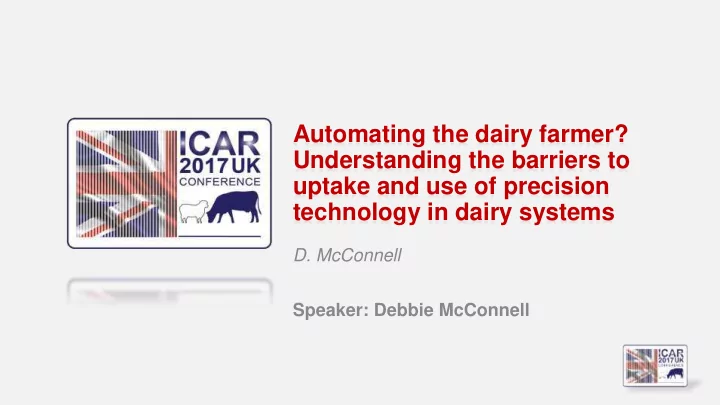

Automating the dairy farmer? Understanding the barriers to uptake and use of precision technology in dairy systems D. McConnell Speaker: Debbie McConnell
Automating the dairy farmer: understanding the barriers to uptake and use of precision technology in dairy systems Dr Debbie McConnell
Precision technology – a changing world Number of connected devices • Emergence of a data-sharing world worldwide from 2012 to 2020 (in billions) 60 50.1 • Agriculture provides a perfect host for 50 42.1 precision technologies 40 34.8 28.4 30 • 22.9 Ability to drive sustainability in dairy production 18.2 20 11.2 14.4 systems: 8.7 • 10 Feeding • 0 Nutrients 2012 2013 2014 2015 2016 2017 2018 2019 2020 • Labour Source: CISCO, 2016 • Technology adoption rates remain relatively low in dairy systems
Study aim How can we make the most out of precision technology in the dairy sector? • Factors limiting uptake of precision technology? • Why people were investing? • How were they ensuring they • >70 interviews with: were getting the most out of the technology? – Industry – Technology manufacturers – Farmers – Researchers
Factors limiting adoption? Other, 9% Too Not suitable complicated or to use, 29% appropriate • Limited evidence base on cost- for my farm, 20% benefit of technology Not cost Not accurate effective enough, 2% • Lack of resource and/or initial setup costs – Financial too high, 50% – Time (DEFRA, 2012) (Bewley, 2014)
Factors limiting adoption? Other, 9% Too Not suitable complicated or • to use, 29% Limited evidence base on cost- appropriate for my farm, benefit of technology 20% Not cost Not accurate • Lack of resource effective enough, 2% and/or initial – Financial setup costs too high, – Time 50% (DEFRA, 2012) • Easy of use – Skillls base on farm – Off-farm support network 45% of UK dairy farmers felt that having better ICT skills was required to embrace use of technology(DEFRA, 2012) (Bewley, 2014)
Why were people What did they look investing? like? • Curious • Younger (with older generation providing • Wanted to be ahead of strategic/financial support) the game/ new challenge • Achieved higher level education • Labour saving/Quality of life • Multiple business enterprises – spread • Better management of financial risk business
How was technology performing on farm? I’m not sure, I think it’s a My herd fertility is good better system, it’s got much now bu t I’m not sure what more data and it cost a lot of it was like before money! Long- term, yes we’d consider more I am not sure what the best metrics robots but we want to get this are to measure against, I look at working correctly first what the sales person told me Measure to Manage? Investing in technology brings greater measurement, not necessarily better management
Adaption process Phases of the learning trajectory of new precision dairy farmers (adapted from Eastwood et al.2012) 6 – 12 months 3 - 6 months 12 months + Early learning Consolidation phase Advanced learning Basic data entry, creating simple Task repetition leading to Combining different data to give groups, descriptive and responsive knowledge consolidation, building more effective decision support activity data interpretation skills processes, tailored to specific needs, additive benefit to farm Opportunity for true cost-benefit assessment
Adaption process Phases of the learning trajectory of new precision dairy farmers (adapted from Eastwood et al.2012) 6 – 12 months 3 - 6 months Lack of: 12 months + Early learning Consolidation phase Data Advanced learning skills Basic data entry, creating Task repetition leading to Combining different data to give simple groups, descriptive knowledge consolidation, building more effective decision support Strategic and responsive activity data interpretation skills processes, tailored to specific needs, additive benefit to farm Guidance Opportunity for true cost-benefit assessment
Building the skills base • Recognising the skill set required on farm is changing – data management and interpretation a key requirement (££) • Making precision agriculture more accessible at an earlier age
Providing strategic guidance • Nick and Rebecca Dornauf, Gala Dairies, Tasmania • Voluntary access, 4-way grazing system • Started in 2010 • 600 cows (400 spring, 200 autumn) • 8000kg milk/cow/year
Providing strategic guidance “We felt quite alone, we didn’t know if what we were doing was right or how we compared to other robot farms” • Need for clear KPIs when implementing precision technology • Greater sharing of data across technology
Using technology to drive grassland production and utilisation • Grassland agriculture will be pivotal to ensuring sustainable N.I. dairy, beef and sheep industries – Significant volatility in price and availability of imported feedstuffs – Environmental and social concerns Significant financial benefit to improving grass growth and utilisation +£441/ha +£204/ha (Mayne and Bailey, 2016)
Changing our understanding of the grazing environment: AFBI Precision Grassland Platform • High-tech research platform which enables the collection of detailed information on soil, plant and animals Soil – Improving Plant – Improving nutrient use efficiency pasture productivity and of grassland pastures quality Animal – Increasing pasture utilisation and milk from forage
Changing our understanding of the grazing environment: AFBI Precision Grassland Platform • Supported by network of farmer co-researchers providing on-farm test bed for new technologies but also key group for sharing experiences and developing KPIs
Summary • Need to move from technology centric view to user centric view of precision agriculture • Technology allows us to measure but not necessarily manage. Need to address skills gap on farm and offer appropriate industry support. • Further integration required between research and technology developers to build appropriate KPI’s for technology • Significant scope to drive grassland production and utilisation with precision technology but farmer engagement key
Recommend
More recommend